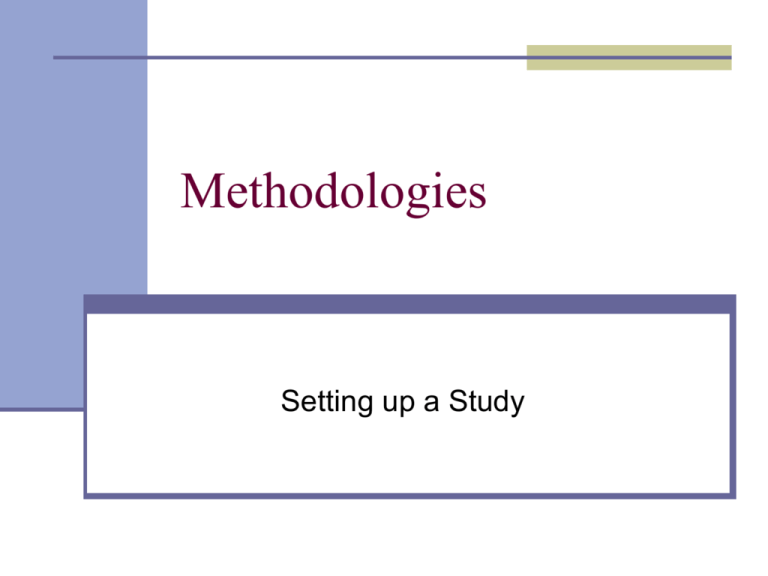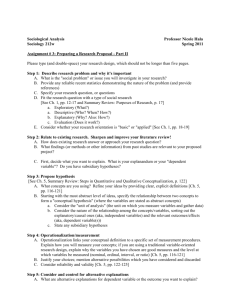Methodology Pt.2 7/8
advertisement

Methodologies Setting up a Study Review Problem Statement Problem Originality Direction Significance Literature Review & Theoretical Framework Logical Structure Research Questions Population Sampling Methodologies Specific systems/ tools/ approaches to gathering and analyzing data. Structure of the research Builds on and draws from previous sections: problem statement, research questions, literature review, theoretical framework Influences analysis How to choose an appropriate method? Methodologies: Options Quantitative Numbers, statistics Qualitative Words, narrative Mixed Methods Both Quantitative and Qualitative Triangulation More than one method, may be two of the same type Methods: Options Quantitative Qualitative Mixed Predetermined Emerging Predetermined and Instrument-based Open-ended questions Performance data, attitude data, observational data, and census data Statistical analysis questions Interview data, observation data, document data, and audiovisual data Text and image analysis emerging Open- and closeended questions Multiple forms of data Statistical and textual analysis -Creswell, J.W. Methodologies: Options Quantitative Surveys Structured Interviews Questionnaires Bibliometrics Transaction Log Analysis Qualitative Case Studies No Contact One-to-one Examining Documents Citation Analysis Diaries Unstructured Interviews Think-Aloud Ethnographic methods Observations Group Interaction Focus Groups Delphi Method Concept Mapping Quantitative: Bibliometrics Quantitative study of literature Patterns of publishing within a field or body of literature Quantitative study of information associated with published works: authorship, publishers, citations Quantitative: Transaction Log Analysis Quantitative study of user behavior as exhibited through computer logs Domains (.gov, .edu, .com) “Hits” Paths followed Time spent (searching, viewing, downloading) Errors Applications used Qualitative: Case Study In-depth review of a single situation: program, process, phenomenon Qualitative: Examining Documents Systematic review of text/ images: content analysis Classifies textual or visual material Uses analytical constructs or rules to draw inferences about recurring aspects of text. Types of Documents? Policy Manuals Digital reference transcripts Comment/ complaint cards Job ads Published Literature Blogs, listserv postings, etc. Open-ended responses Evaluation Research Published Books Journal articles Conference proceedings Theses/dissertations Web ALA. ACRL. CIP Notes CLIR. www.clir.org/pubs/pubs.html ARL Other Peer Review Unpublished Internal reports Local use only reports Qualitative Analysis: Examining Documents Focus on: Word choice Word frequency Word sequence Intensity of feeling/ expression (how to measure?) Key word in context Typology of concepts/ categories? Example Regional Accreditation Organizations’ Treatment of Information Literacy Qualitative Study: Citation Analysis Systematic review of bibliographies/ references within published literature. Focus on Authorship Form of publication (periodical, monograph, etc.) Class of material (primary, secondary, etc.) Language Subject Currency Citation Analysis What can citations tell us? How scholarly is the cited literature? How current are the citations? How research-oriented is it? How interdisciplinary is it? How writes the literature? How collaborative? Where does the literature appear? Citation Analysis Growth of literature on a subject Dispersion of writings on a subject across form and journals Obsolescence of literature Scholarly networks: who cites whom? Publishing productivity Citation Analysis Advantages Shows what is cited Does not involve interaction with subjects Profiles a literature Shows changes in a field over time? Disadvantages How complete is the work from which citations are drawn? How accurate are citations? Are all materials cited? Choosing easy to find/ retrieve items over better quality? How easily retrievable are works? Citation Analysis: Issues From where are citations drawn? How far can you generalize findings? Does citation reflect use? Self-citations and/ or gratuitous citations Half-life Impact factor (to what extent are recent articles in journals cited?) Calculated annually: divide the number of current citations a journal receives to articles published in the previous two years by the number of articles published in those same years Web Citations How “prestigious” are different online sources- ejournals, open access, etc. References to and from a Web site Retrievability Qualitative Study: Diaries Participants record activities, thoughts, reactions, etc. daily (weekly, etc.) over a set period of time. Blogs- equivalent? When to use? Issues How faithful are participants? How can you help ensure full participation? How much guidance to give? Too much/ too little detail. Advantages and disadvantages? Students’ World Nicole Henning/ Photo Diary Study (MIT) 16 students tracked their information seeking behavior for one week. Used diaries and screen shots to record their thoughts and actions Qualitative Study: Interviews Attempt to gain in-depth knowledge on a topic In a less structured format, interviewer may act more as facilitator, asking open ended questions and drawing the participant out. Structured, semi-structured, or unstructured? Format- in person, telephone, email? Interviews Types of questions: Experience/ behavior Feeling Opinion/ value Knowledge Sensory Demographic Interviews Issues Logistics Building trust Delicate questions/ situations- ensuring honesty Accuracy of transcripts Advantages and disadvantages? Appropriate uses? Qualitative Study: Think-Aloud Asks respondent to verbalize their thoughts while performing an assigned activity or task Attempt to gain more insight into thought processes Correct for mistakes/ assumptions of observer Think Aloud Requires participants that are highly verbal in nature Adding this layer of feedback may affect their cognitive processes and behaviors- more “self-concious.” How to transcribe while observing? Accuracy? Appropriate use of clarifying questions? Appropriate uses? Qualitative Study: Ethnographic Tools developed in the field of cultural anthropology Attempt to better understand people/ behavior by observing it within natural setting Can study observable material items, individual behaviors and performances, or ideas Requires careful attention to detail within cultural context Ethnographic Possible Tools: Observation in context Key informant interviewing Drawing pictures Taking photos Using maps to track activities Videotaping Ethnographic: Examples Susan Gibbons and Nancy Fried Foster of University of Rochester: Understanding Users to Develop Better Library Services (ACRL/NEC 2006) User-centered studies of library use… Mapping Diaries Photo Elicitation Interviews Photo Elicitation Mapping Diaries Sweeping Studies A type of spatial data analysis Useful for mapping out the physical spaces of a library and investigating how people use those spaces Qualitative Study: Observation Attempt to understand activities/ behaviors Obtrusive or Unobtrusive Role of the observer: Complete observer Observer and participant Participant with individual being observed Qualitative Study: Focus Groups Attempt to learn about the attitudes/ beliefs/ feelings of groups and how those influence behavior Why groups? One individual’s comments can trigger important responses from others. Can explore large ranges of topics Focus Groups Issues How structured? Importance of facilitator’s role- how well trained? Building trust Finding reliable representative volunteers Ensuring accuracy of transcription- audio/ video tape? Outside observation? Facilities Qualitative Study: Delphi Method A “systematic interactive forecasting method.” Involves interviewing/ surveying of experts within a field- generally 9 to 99 Experts are provided with hypotheses, trigger statements, scenarios, etc. and asked to respond. First round responses are shared with the group anonymously, so participants can revise earlier statements, react to responses. Delphi Method After several rounds, hypotheses may be refined, group may reach “consensus” Facilitator reviews responses to each roundcan filter out irrelevant content, choose presentation of information, ask questions. Advantages and disadvantages? Qualitative Study: Concept Mapping “Any process that represents ideas in pictures of maps.” A method of organizing the ideas and thoughts of a group to form a common framework Can be used to integrate ideas from less structured activities such as brainstorming Concept Mapping Typical steps: Focus: determine desired outcomes/ questions to be addressed Generating ideas: Brainstorm, use trigger statements, ask questions Analysis: Sort ideas into large sets Unstructured idea sorting: ask individuals to sort ideas into groups and label Sorting by stakeholders: organize ideas by group that generated those ideas Ratings: assign values to ideas (importance, feasibility, etc.) Concept Mapping Map analysis: generate map based on idea sorting (could use statistical software, or do by hand) Interpret map: Share with other groups to obtain understanding Example: IR and IL







